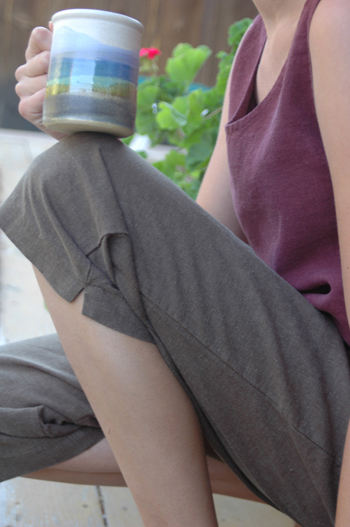Sustainable women’s clothing: beyond mere buzzwords
Buying organic women’s clothing is pretty straightforward—just read the label, right?. Actually, shopping for truly sustainable women’s wear is tricky. As with words like "green" and "Earth-friendly," marketers have jumped on the sustainability bandwagon, blurring its meaning. Here's a quick rundown to help you cut through the hype when you shop for natural women’s wear that is truly sustainable .
Lauren’s Tuxedo Top and Angled Skirt are sustainably handcrafted in the U.S., using a sustainable blend of hemp and Tencel.
What Makes Manufacturing Processes and Products Sustainable?
Sustainably designed manufacturing processes and products take into account their economic, social and ecological impacts. They use no non-renewable resources, impact the environment minimally and help us engage with our natural environment.
Related: Sustainability: It's Complicated…and Simple
While the USDA's organic certification standards are clear, there are no such legal standards for sustainability.
That said, the standards driving the sustainability movement are clear and serve as a test in weighing just how sustainable a manufacturer’s womens clothing is. (Of course, that depends on the manufacturer being transparent about its processes —something often not present with fast fashion.)
Sympatico’s Cropped Pants and Tank Top are crafted with sustainable fabric made in a closed-loop system that protects the environment.
Sustainable Design and Manufacturing Principles
-
Low-impact materials: choose non-toxic, sustainably produced or recycled women’s wear that requires little energy to process
-
Energy efficiency: use manufacturing processes and produce women’s clothing that requires less energy
-
Quality and durability: longer-lasting women's wear is replaced less, reducing the impacts of producing new garments
-
Design for reuse and recycling: products are designed to offer a commercial "afterlife"
-
Design impact: Sustainable manufacturers calculate product's total carbon footprint
-
Biomimicry: industrial systems modeled on biological lines allow reuse of materials in continuous closed cycles
-
Service substitution: shifting the mode of consumption, for example from a private auto to a carsharing service.
-
Renewability: use materials from local or bioregional sources that sustainably manage renewable sources and compost when their usefulness is exhausted
-
Robust eco-design: robust design principles are applied to control all pollution sources
Learn how Sympatico’s hemp/Tencel womens wear practices sustainability.
Dig Deeper: Clothing as Art, not Stuff
Drill Down: Shipping & Shopping: Making Choices That Minimize Our Footprint






